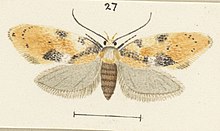Tingena berenice
| Tingena berenice | |
|---|---|

| |
| Female holotype | |
| Scientific classification | |
| Domain: | Eukaryota |
| Kingdom: | Animalia |
| Phylum: | Arthropoda |
| Class: | Insecta |
| Order: | Lepidoptera |
| Family: | Oecophoridae |
| Genus: | Tingena |
| Species: | T. berenice
|
| Binomial name | |
| Tingena berenice | |
| Synonyms[2] | |
| |
Tingena berenice is a species of moth in the family Oecophoridae.[2] It is endemic to New Zealand and has been found in the North and South Islands. It is a brightly coloured species which is on the wing in November. Its preferred habitat is mixed beech forest.
Taxonomy[edit]
This species was described by Edward Meyrick in 1929 using specimens collected by George Hudson in November in Wellington and named Borkhausenia berenice.[3] In 1988 J. S. Dugdale placed this species in the genus Tingena.[2] The female holotype specimen is held at the Natural History Museum, London.[2]
Description[edit]

Meyrick described the adults of this species as follows:
♂. 15 mm. Head whitish. Palpi whitish, second joint irrorated dark grey except apex. Thorax grey-whitish, posteriorly tinged pale fulvous on margins. Forewings elongate, costa gently arched, apex obtuse, termen rounded, rather strongly oblique; ochreous-whitish, becoming pale ochreous-yellowish posteriorly and towards dorsum anteriorly; a very oblique fascia of grey suffusion from base of costa to middle of dorsum; costal spots of grey irroration at 1⁄3 and 3⁄5; a subtriangular blackish blotch on dorsum about 3⁄4, surrounded by broad light fulvous irroration or suffusion extending to tornus and 3⁄4 across wing: cilia whitish-ochreous. Hindwings grey; cilia pale grey.[3]
This species is brightly coloured.[4]
Distribution[edit]
This species is endemic to New Zealand.[1] It was first collected by Hudson in Gollans Valley and has also been found near the Homer Tunnel.[4][5]
Behaviour[edit]
Adults of this species are on the wing in November.[4]
Habitat[edit]
This species preferred habitat is mixed beech forest.[4]
References[edit]
- ^ a b Gordon, Dennis P., ed. (2010). New Zealand inventory of biodiversity: Kingdom animalia: chaetognatha, ecdysozoa, ichnofossils. Vol. 2. p. 462. ISBN 978-1-877257-93-3. OCLC 973607714. OL 25288394M. Wikidata Q45922947.
- ^ a b c d John Stewart Dugdale (23 September 1988). "Lepidoptera - annotated catalogue, and keys to family-group taxa". Fauna of New Zealand. 14. Department of Scientific and Industrial Research: 100. doi:10.7931/J2/FNZ.14. ISSN 0111-5383. Wikidata Q45083134.
- ^ a b Edward Meyrick (30 November 1929). "Descriptions of New Zealand Lepidoptera". Transactions and Proceedings of the New Zealand Institute. 60: 488–489. ISSN 1176-6158. Wikidata Q104179283.
- ^ a b c d George Vernon Hudson (1939), A supplement to the butterflies and moths of New Zealand, Illustrator: George Hudson, Wellington: Ferguson and Osborn Limited, p. 444, OCLC 9742724, Wikidata Q109420935
- ^ W George Howes (September 1946). "Lepidoptera collecting at the Homer, with descriptions of new species". Transactions and Proceedings of the Royal Society of New Zealand. 76: 139–147. ISSN 1176-6166. Wikidata Q62091906.
